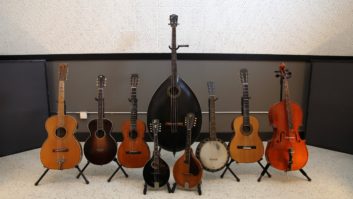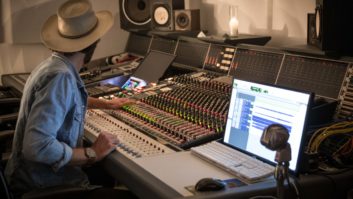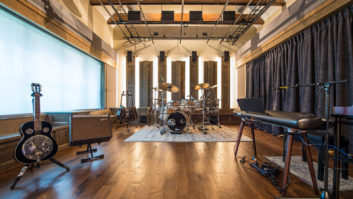A bird’s eye view of Southern Ground’s large tracking room, featuring newly-exposed brickwork from its origins as Addison Avenue Presbyterian Church, circa 1903. NASHVILLE, TN—If Music Row is largely selling out, Zac Brown isn’t buying it. Or, more accurately, he is buying it, having purchased and heavily rehabilitated the studio now known as Southern Ground Nashville.

In 2012, Brown began the search for a studio space to record and produce records for his Southern Ground family of artists. Chief engineer Brandon Bell recalls, “Zac looked for space in Atlanta for a while, where he lives and calls home. Meanwhile, Matt Mangano [Zac Brown Band bassist/Southern Ground Nashville Director] and I knew the mastering engineers that shared the 7,000-square-foot former Masterlink facility and presented the idea of buying it to Zac.” After the offer was accepted, Brown and Mangano literally began a top-down overhaul.
Originally the Addison Avenue Presbyterian Church, constructed in 1903, the building is a church-turned-VFW Post-turned classic Music Row recording studio: Fred Foster’s Monument Records’ facility, first unveiled in 1968. As a studio, it changed hands two more times before becoming Southern Ground Nashville: in the mid-’70s as Chip Young’s Young’un Sound and in the early ’80s, as the Al Jolson, Jr.-owned Masterlink.
“It’s been added to, taken away from, plastered over, and so on,” explains Bell. “Zac and Matt found the rafters above the cloth ceiling in the tracking room—buried beneath insulation, dry wall, and so on—looked really cool. Above the studio, a lot of the original brickwork had never been plastered over, so they decided to pull the entire ceiling down—fabric, insulation and all—to expose it, the beams, and feature the original ceilings with up-lighting. They also removed much of the plaster on the walls to expose the original brick where possible.”
Unique Koa flooring was installed, too. “We got a lot of wood from Taylor Guitars—‘seconds’ that they couldn’t use for guitars, but that were still amazing. They had a complete Koa tree that had frozen at some point; it wasn’t usable for making guitars, but it was perfectly repurposed for the flooring.”
Overall, the former Masterlink tracking space gained aurally pleasing reverb time. “It livened the room a lot,” confirms Bell. “It’s really hard to beat this room for drums. Because all of this space has been opened up, it’s an entirely new acoustic space.”
Bell explains that Brown and Mangano were careful to not fix what was not broken. The emphasis was on restoration from the very beginning. “Initially, the bulk of the changes were cosmetic. They revealed a lot of the inherent beauty of the building and enhanced the historical appeal of the exterior façade, too; outside we pulled off a lot of the sprayed-on stucco, exposing the brick and adding copper paneling.”
According to Bell, it was Jolson’s ownership and specifically the work of engineer Chad Hailey that gave the former Masterlink “its first run as a state-of-the-art recording facility,” specifically in facility-wide wiring overhauls and equipment-based innovations. “Up until that point, it had been serviceable. Fred Foster himself said that it was never quite what he had hoped it would be. But Jolson made crucial renovations, added great tape machines and more, which brought it to ‘cutting edge status’ for its time. Chad Hailey was behind all this, too, making incredible technical improvements in wiring; still today, everything is very easy to disconnect, move and clean, and is so well-labeled and repaired.”
The studio came equipped with a lot of great gear to which the Southern Ground guys significantly added. “The console is a 60-input Neve V3 [with VR master section and Flying Faders automation],” tells Bell. “The studio came with two Otari MTR-100 two-inch tape machines, an Ampex ATR-102 two-track, a Studer four-track, an old Otari two-track—which are all interesting pieces. The studio also had a great vintage mic collection that we have supplemented as needed.”
Engineer/ZBB member Matt Mangano at Southern Ground’s Neve V3 tracking console. A few upgrades include an Avid Pro Tools HDX rig (versions 10 and 11) with Apogee Symphony converters and 48 tracks of Endless Analog’s CLASP Closed Loop Analog Signal Processing. “It’s top notch,” notes Bell of the CLASP rig. “So, we have 48 channels of tape alongside Pro Tools, the best of both worlds.”

An unfinished room in the Masterlink facility gave Southern Ground an opportunity to build a separate mix room, featuring a 60-channel SSL 4000 G+ console paired with ATC SCM300 Main Monitors. “That room gave us an opportunity to dream,” explains Bell. “We hired Steve Durr to design and oversee the room’s build-out. Matt, Clay Cook and I went back and forth when selecting the right outboard gear. None of it was pretentious or esoteric—all staples that people have seen, used and preferred—that would be a great compliment to the console.” These include EQs from API, GML, Maag and Retro; compressors from BAE, dbx, Empirical Labs, SPL and UA; outboard effects from Lexicon, Line 6, TC Electronic and Tech 21, extra converters from Crane Song, and three classic EMT 140 plate reverbs.
Several basement spaces were built out, too. “We’ve added two isolation chambers to isolate guitar amps as well as a small tiled chamber,” adds Bell. “We also built an isolation booth for the new Leslie cabinet downstairs.”
Though Southern Ground Nashville is primarily a studio for Brown and Co.’s big, happy family of recording artists, they want it to be more than that. Confirms Bell, “It’s been quiet at first—initially a ‘friends-of-friends’ client basis—but we want to be open to the public, for the most part.”
What’s the best part about being Southern Ground, a new recording studio business that is 100-percent artist owned? The pressure of developing traditional studio income streams is reduced dramatically. “Sure, everyone likes to make money,” postulates Bell, “but the priority is to make great music. Already this building has helped make a lot of great music. We just believe there’s a lot more to be made here.”
There’s also the motivation to preserve crucial pieces of Music Row’s illustrious recording studio history. “You know, there was a strong chance that this building was going to become a Mexican restaurant,” explains Bell. “It hurts to drive down Music Row and see buildings that I worked in that are no longer studios. I understand moving forward, building condos and such, and how things come and go, but it’s never good to lose your history and legacy.”
Southern Ground Nashville
southerngroundnashville.com







